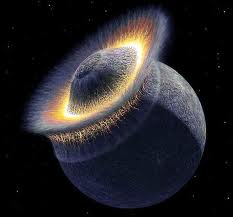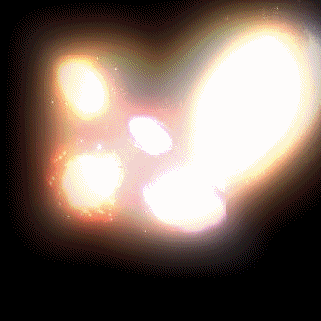.jpg) |
| Image by John Fowler |
The Moon is a prominent and receding presence in our lives. Silent and invariable, its waxing and waning phases, its visual presence and absence, imprints us with the cyclical patterns of nature.
The Moon's prominence in the evening sky, and its predictable phases, have influenced art and created mythologies since antiquity.
A full luminous Moon reveals the same face because, like the tuned gears of a watch, it is in synchronous rotation with Earth.
“Her antiquity in preceding and surviving succeeding tellurian generations: her nocturnal predominance: her satellitic dependence: her luminary reflection: her constancy under all her phases, rising and setting by her appointed times, waxing and waning: the forced invariability of her aspect: her indeterminate response to inaffirmative interrogation: her potency over effluent and refluent waters: her power to enamour, to mortify, to invest with beauty, to render insane, to incite to and aid delinquency: the tranquil inscrutability of her visage: the terribility of her isolated dominant resplendent propinquity: her omens of tempest and of calm: the stimulation of her light, her motion and her presence: the admonition of her craters, her arid seas, her silence: her splendour, when visible: her attraction, when invisible.”The Word
― James Joyce, Ulysses
The word Moon is derived from the Old English mona, the Germanic mene, the Middle Dutch mane, the Old Saxon mano, as well as from Old Icelandic and Danish influence. Luna is the Latin word for Moon. The late Middle English word Lunar meaning ― of or related to the Moon ― is derived from the Latin luna.
Genesis
 |
| Depiction of Theia crashing into Earth |
Planetary scientists believe the Moon settled into its current configuration about 4,500,000,000 yeas ago. Anatomically modern humans appeared on Earth about 200,000 years ago which means the Moon is more than 20,000 times older than us.
The Giant Impact Hypothesis posits that the Moon was formed from debris caused by a glancing collision between the a protoplanet Earth and a planetoid about the size of Mars called Theia ― named after the mythical Greek Titan and mother of Selene, the goddess of the Moon.
Evidence supporting the Giant Impact Hypothesis is:
- Earth's spin and the Moon's orbit having similar orientations, and
- Stable isotope ratios of Earth and Moon rock are identical which infers a common origin.
We all shine on...like the moon and the stars and the sun...we all shine on...come on and on and on...
― John Lennon
 |
| Moon spots in the forest, winter Arkhip Kuindzhi (1842–1911) |
REFERENCES
- Broken World by Brian Koberlein, 25 March 2014.
- Giant Impact Hypothesis, Wikipedia.
- Origin of the Moon in a giant impact near the end of the Earth's formation, Robin M. Canup & Erik Asphaug, Nature, Volume 412, 16 August 2001.
- Science Diction: The Origin Of The Word ‘Moon’, Science Friday, 20 January 2012.
- Ulysses, James Joyce, Sylvia Beach 1922.









